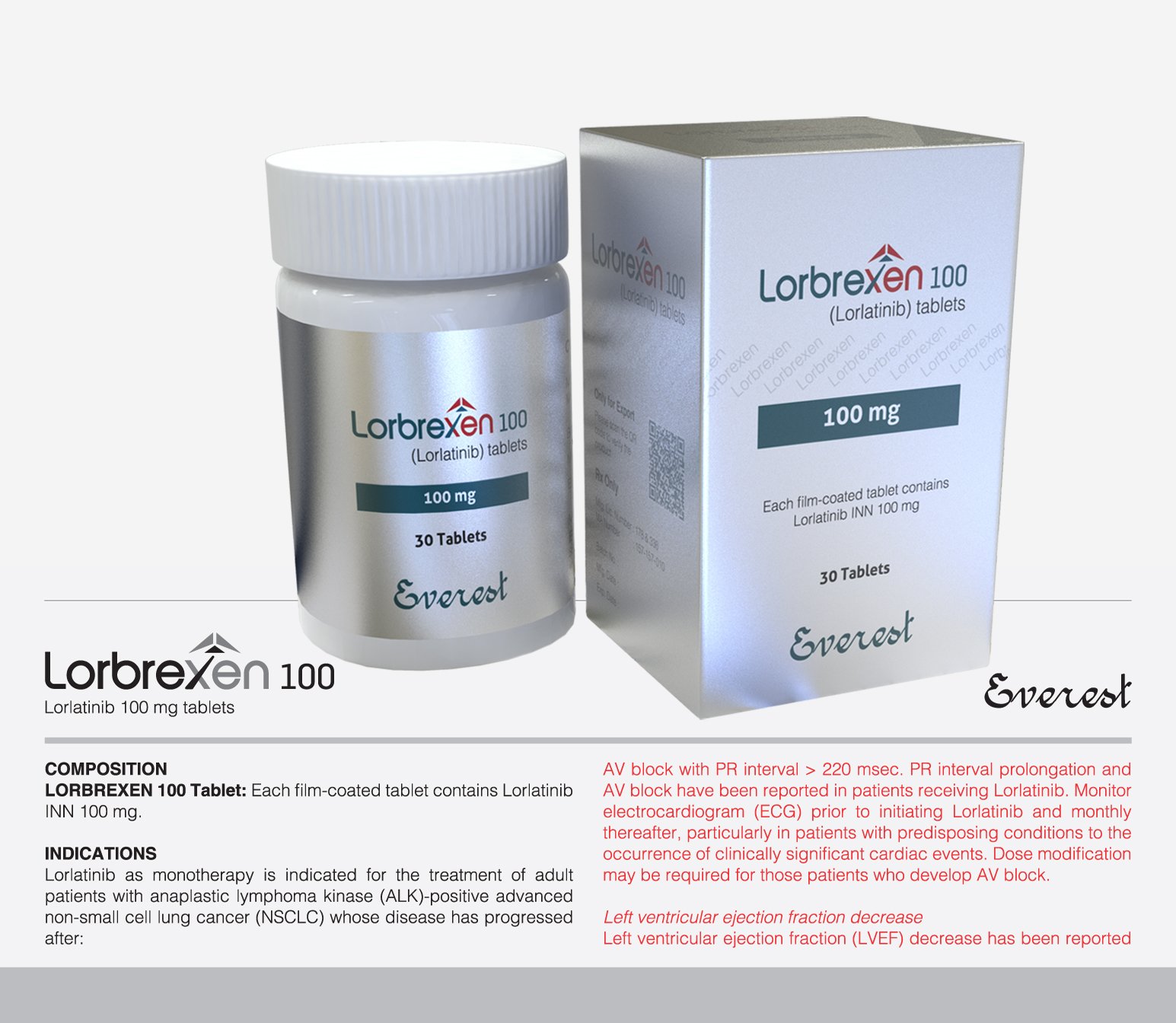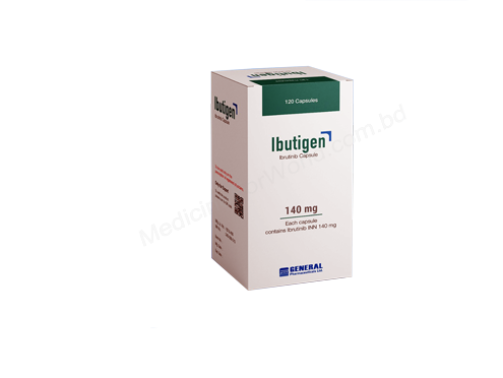Lorlatinib 100 mg (Lorbrena)
0.00$
Lorlatinib, also known by its International Nonproprietary Name (INN), is a medication employed to treat specific cancer types, notably non-small cell lung cancer (NSCLC). Functioning as a third-generation inhibitor of ALK and ROS1 tyrosine kinases, lorlatinib targets particular genetic mutations, thus impeding the growth and spread of tumors. Its efficacy has been evident in ALK-positive metastatic NSCLC patients, even those resistant to prior ALK inhibitors. Lorlatinib exhibits promising outcomes in enhancing progression-free survival and overall response rates, presenting a valuable therapeutic option for advanced-stage disease.
Lorlatinib created the precision medicine Lorlatinib, sold under the brand name Lorbrena, to treat non-small cell lung cancer (NSCLC) that is ROS1 gene rearrangement or anaplastic lymphoma kinase (ALK). It is especially useful for patients who have become resistant to ALK inhibitors of the first generation.
Mechanism of Action
A third-generation tyrosine kinase inhibitor (TKI), lorlatinib is active against brain metastases, a frequent adverse effect of ALK-positive non-small cell lung cancer (NSCLC), via penetration into the blood-brain barrier. It blocks the signaling pathways that lead to the growth and survival of cancer cells by selectively blocking the tyrosine kinases ALK and ROS1.
Dosage and Administration
A third-generation tyrosine kinase inhibitor (TKI), lorlatinib, is effective in treating brain metastases, an adverse effect common to ALK-positive non-small cell lung cancer (NSCLC), via penetration across the blood-brain barrier. It blocks the signal transduction mechanisms that lead to the growth and survival of the cancer cells by selectively blocking the tyrosine kinases ALK and ROS1.
Dosage Forms and Strengths
Lorlatinib 100 mg (Lorbrena) comes in two tablet strengths:
25 mg: 8 mm round, tan, immediate-release, film-coated tablets debossed with “Pfizer” on one side and “25” and “LLN” on the reverse side.
100 mg: lavender, immediate-release, film-coated, 8.5 mm × 17 mm oval tablets with the words “Pfizer” on one side and “LLN 100” on the other.
Side Effects
The following are Lorbrena’s typical side effects:
Swelling of the hands, feet, arms, and legs is known as edema.
Limb and joint tingling and numbness (peripheral neuropathy)
Weight gain
Cognitive impairment, including confusion and forgetfulness
Fatigue
Dyspnea, or breathlessness
Pain in the joints (arthritis)
Diarrhea
Emotional changes, such as depression and irritability
Elevated triglyceride and cholesterol levels
Coughing
Severe side effects include:
Heart issues, including atrioventricular (AV) block and abnormal or slow heart rhythms
Lung issues, including interstitial lung disease (ILD) and pneumonia (lung inflammation)
Hypertension, or high blood pressure,
The condition hyperglycemia
If a patient has symptoms like dizziness, fainting, chest pain, shortness of breath, coughing, fever, or symptoms of high blood sugar, they should notify their healthcare provider.
Precautions and Contraindications
Since Lorbrena can lead to significant hepatotoxicity, it should never be used in subjects who are on potent CYP3A inducers. Moderate CYP3A inducers should not be given concomitantly, and if this is unavoidable, the dose of Lorbrena might be required to be reduced. Patients with significant renal impairment may need a lower dose.
These need to be tested for confirmation of ALK or ROS1 gene rearrangements prior to initiating treatment. While on treatment, it is advisable to monitor blood pressure, blood sugar, liver enzymes, cardiac rhythm, and lipids regularly.
Reproductive Considerations
An unborn child may be harmed by Lorbrena. Men with a reproductive-aged partner should use effective non-hormonal contraception for at least three months after the last dose, and women should use it for at least six months on therapy. Hormonal contraceptives may not work when used with Lorbrena. Avoid breastfeeding during treatment and for one week after the last dose.
Conclusion
In patients with ALK- or ROS1-positive metastatic non-small cell lung cancer (NSCLC), particularly those who are progressing on earlier ALK inhibitors, Lorlatinib (Lorbrena) provides a targeted therapy. It is specifically beneficial in brain metastasis due to its capability to cross the central nervous system. But careful monitoring and consultation with a healthcare provider are necessary during therapy because of possible side effects and drug interactions.
Order Now At Mdx Pharma bd….
To order from MDX Pharma BD, visit their website at https://mdxpharmabd.com, where you can browse products and place orders online. For inquiries or orders via email, contact emedicarepharma@gmail.com. Alternatively, call (+88) 01929123476. Their address is 29, Abdullahpur, Uttara, Dhaka-1230, Bangladesh.
1. What are the uses of Lorlatinib (Lorbrena)?
Adults with metastatic non-small cell lung cancer (NSCLC) that is either ROS1-positive or ALK-positive are treated with lorlatinib. It is usually advised after previous ALK inhibitor treatments if the tumor has progressed.
2. How does the drug Lorlatinib work?
The tyrosine kinase inhibitor (TKI) lorlatinib inhibits aberrant ALK or ROS1 proteins that lead to the development of cancer cells. Thus, it stops or delays the spread of cancer.
3. How does one administer Lorlatinib?
The solution is to take it orally once a day, with or without food. The standard daily dosage is 100 mg, unless your doctor prescribes a different amount.
4. Can the blood-brain barrier be crossed by Lorlatinib?
Lorlatinib’s ability to enter the central nervous system (CNS) and effectively combat brain metastases in ALK-positive non-small cell lung cancer (NSCLC) is one of its benefits.
5. Can Lorlatinib be taken with other medications?
Because lorlatinib interacts with CYP3A enzymes, avoid strong CYP3A inducers or inhibitors (such rifampin, St. John’s Wort, or certain antifungals). Discuss any prescription drugs and dietary supplements with your oncologist.
6. How long is Lorlatinib taken by patients?
The medication is taken for as long as it is safe and effective, or until the cancer worsens or the adverse effects become intolerable.
| Product Name | Lorbrexen |
|---|---|
| Generic Name | Lorlatinib INN |
| Formulation | Tablet |
| Available Pack size | 30 Tablets |
| Strengths | 100 mg |

 Cart is empty
Cart is empty 



